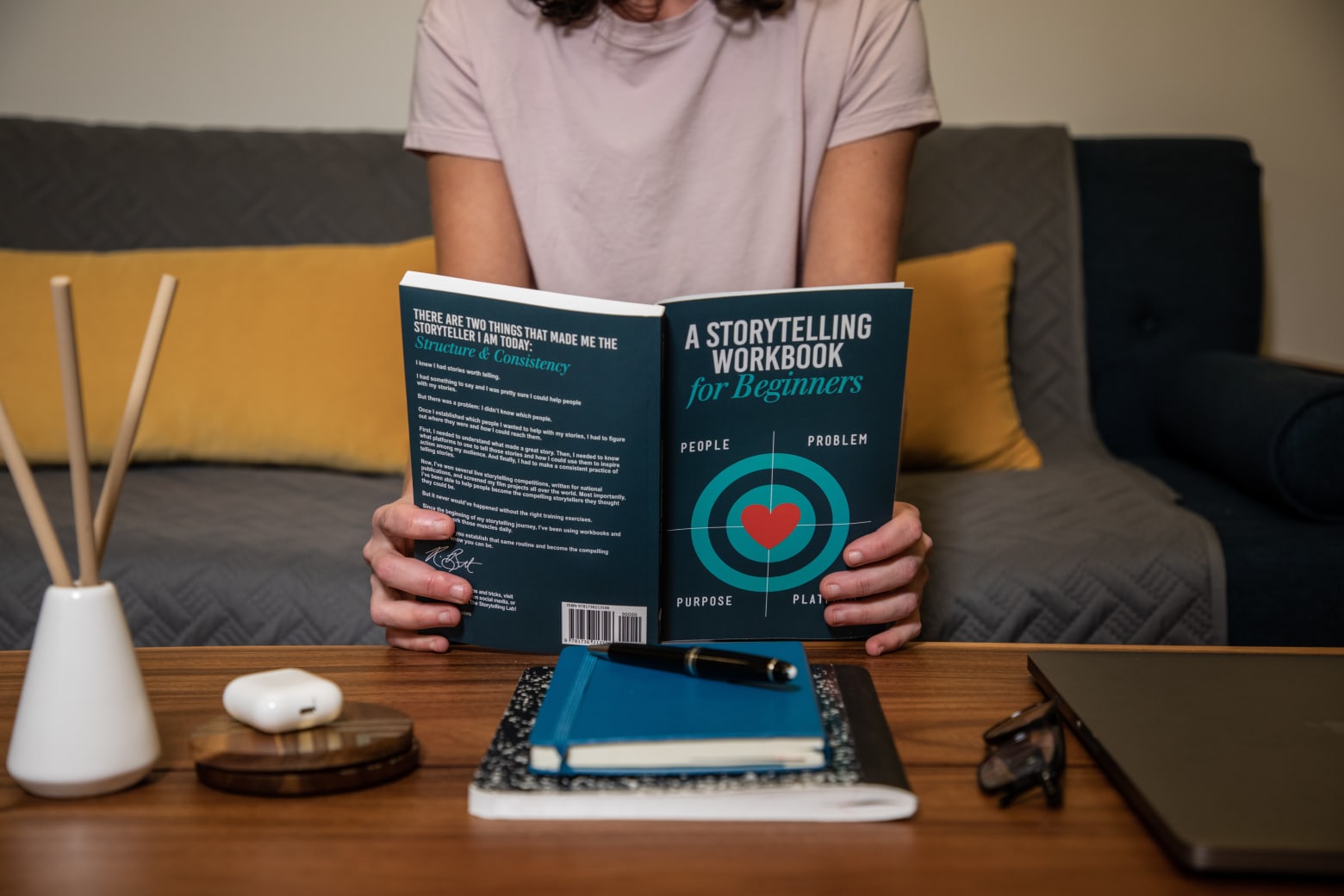
Table of Contents
As the hottest job of this century, data science understandably has a large following of students and professionals who are looking to break into the field. As a result, almost every week I meet at least one highly promising candidate, either in person or on LinkedIn, who is looking for advice on how to land a job as a data scientist. They usually have at least one degree (and, sometimes, an advanced degree) in engineering, math, or another STEM field, and they are actively looking for a job in data science. They have completed any number of relevant courses on Python, R, and Statistics, and are a regular at all the relevant meet-ups and events in Boston. Their story is always the same: they have responded to countless job posts from companies big and small, and they have even been invited to interview a few times, but they have yet to get an offer. They are not yet a Data Scientist.
"What's missing?" you might ask.
The missing ingredient in almost all cases is storytelling. Telling an engaging and coherent story is crucial, not only to getting a job as a Data Scientist, but also to being successful in this role. When networking for a data science role, a good story will brand you as the memorable candidate who stands out from the dozens of hopefuls that the recruiter or hiring manager meets, which will dramatically increase your chances of getting an interview and, ultimately, an offer.
How to Build Your Personal Brand in Data Science
Here are six things that go into building a personal brand and telling a great story when looking for a data science job:
1. Present Yourself as a Data Scientist
Up to 70% of communication is non-verbal, which means that you begin telling your story long before you open your mouth to say "hello." People form a first impression of someone they meet for the first time within seven seconds, and decide whether that person is trustworthy within a tenth of a second! Your clothing sends a critical message about you during those few seconds, so you’ll want to make sure that message is a positive one.
While most tech companies (and, increasingly, many main street companies) have a casual dress code where almost everything goes, a careless outfit and general appearance will work against you when networking in person or interviewing for a data science role.
Don’t get me wrong - a full suit and tie can be just as inappropriate as a pair of sweatpants and a torn T-shirt. While showing up in sweatpants can bring into question your sense of responsibility, the full suit can look dated and boring, or even conjure up images of slow and bureaucratic old school office workers.
When looking for a data science job, a smart-looking, business casual outfit is your best bet. Your clothing should describe you as the bright and active professional that you are, ready to roll up your sleeves and add value to your employer. Even jeans can be appropriate when interviewing for a data science role, provided that they are in a conservative color, not torn or frayed, and are paired with a white button-up shirt and a blazer.
For more specific guidelines on defining a modern, professional clothing style, here are two books I recommend, for men and women respectively:
Image Source: Amazon.com
Article continues below
Want to learn more? Check out some of our courses:
2. How Data Scientists Should Act for Success
Other than your clothing, your body language is your number one asset for making a good first impression when networking or interviewing for a data science job. When it comes to body language, how you feel on the inside will always be reflected on the outside, so it is important to put yourself in a positive and self-confident state of mind.
Here are a few things to be mindful of in order to project the best image of yourself in a networking or professional conversation:
- Smile
- Maintain eye contact while in a conversation
- Shake hands firmly
- Stand/sit up straight
- Angle your body so both your shoulders are facing the person you are addressing.
- Project your voice and try to deepen it a bit.
- Be alert, but not anxious.
- Breathe.
If controlling your body language seems difficult at first, try paying attention to other people's body language when in conversation. These two books are a light but interesting read on this topic:
Image Source: Amazon.com
While this might sound cliché, simply try to be yourself and relax into the conversation. It is important to mentally position yourself on equal footing with the person in front of you, whether they are higher, lower, or equal to you on the professional ladder.
I have seen many stellar candidates melt into a puddle when meeting the CEO of a larger company or a VP of data science, just because their titles sounded intimidating. If you feel anxious talking to that VP, and you start speaking faster, or your palms get sweaty, take a deep breath and relax your shoulders. Remember that the person standing in front of you was once just like you, and that she too needed the support and encouragement of other people to get to where she is. Sometimes, she will remember that too.
3. Listen and Learn from Other Data Scientists
Listening actively is a very important part of storytelling that is often overlooked. Everyone loves to talk about themselves and their achievements, and when they have the undivided attention of the person in front of them, they will typically remember that person in a very favorable light. Listening actively is a great way to build rapport, find common ground, and even make new friends.
While building rapport is crucial to success in all walks of life, it is not the only goal you should have when listening. Listening to the other person talk about their projects and the challenges opens up ways for you to provide value to them. Is she working on way to do XYZ? You could mention that new JavaScript library that you recently read about, and that people are using to do XYZ. Is he a fellow job seeker looking to transition to data science? You could point him to Edlitera, or to other resources that you’ve been using in your own job search. Is she looking for new speaker opportunities? Offer to email her the name of that new data science conference you heard is coming to town in a few months. Even better, if you know someone on the organizing committee, offer to make an introduction for her to inquire about speaking gigs.
You get the picture: always think of a way in which you can help out and add value, and you will be well on your way to building a valuable and diverse network of people who will be much more likely to remember you when you reach out to them for a favor.
Here are some good conversation starters to get people to talk about themselves (Tip: these are also great questions to ask of your interviewers – all of them, even at the same company!):
- What path did you take into data science?
- How did you get started in the field?
- What is your favorite thing about your role?
- How about your least favorite?
- If you were to start over in your career, would you do anything differently?
For further reading, the following two books are good bets on the topic of starting conversations and building rapport. Of the two, Dale Carnegie's book is by far the more influential of the two, so if you can only read one, I recommend starting with that.
Image Source: Amazon.com
4. Craft Your Own Story as a Data Scientist
A good place to start in crafting your own story is by answering the first question above about yourself. We all have our own path, and telling your story is often a matter of perspective.
Maybe you studied math in college and then did an MBA in Marketing. You then worked as a Marketing Manager for a few years, and taught yourself to code a bit just to automate some of the more repetitive tasks in your job. And you really liked it! You’ve always worked with data to some extent and you heard about Kaggle, so you started doing some of the challenges and realized that you’d love to do this full time, so you’re looking to transition into a data science role. You had a lot of fun implementing a recommendation algorithm in the last competition, and you heard that XYZ company is looking for a Data Scientist for just this type of project, so you’d like to learn more.
For instance, I studied behavioral economics, and I’ve always been fascinated by human behavior (why people do what they do) and how to influence behavior. I started my career on the business side of biotech, and then moved on to a company in data tech. Both of my roles have been highly data-driven, and toeing the line between business and engineering, the mix of which I’ve always enjoyed. However, I’ve always felt that the impact I could make was fairly limited in those roles. I love learning and deep diving into large data sets to tell a story about human behavior, so Data Science was a natural next step towards making a greater impact.
For more reading on storytelling and crafting a compelling personal brand story, I recommend Lisa Cron's Wired for Story. It is aimed primarily at writers, but the storytelling rules it sets forth stand for oral presentation and stories as well.
Image Source: Amazon.com
5. Network within the Data Science Field to Succeed
“We rise by lifting others.”
-Robert Ingersoll
Like running a business, networking is an exchange of values. You might have heard that networking is perhaps the best way to find a job. You make new acquaintances in hopes that, one day, they will know someone who knows someone who could help you learn about or unlock a new opportunity. In return, you repay your contacts by doing the same for them, whenever you get a chance.
As human relations go, it is never guaranteed that all your favors will be returned, nor should you ever expect that. However, always helping out and providing value to people you meet is also a great way to build a positive reputation. For better or worse, we live in a highly connected world, and it is very likely that the hiring manager you just interviewed with will look for you on LinkedIn and discover that her best buddy from college is also a connection of yours. When that happens, how your connection remembers you can make or break your chances of getting the job.
You hopefully know by now that being rude or obnoxious to people is never a good strategy. The example above is only one reason out of many why such behavior may only help you shoot yourself in the foot later on. But what many people don’t realize is that the difference between a neutral and a positive review from your acquaintance during that call can also be significant when it comes to getting hired. Consider the difference between the following two conversations:
NEUTRAL:
Hiring Manager: Hey Ann, I’m considering hiring this guy, Alan Smith. It looks like you’re connected to him on LinkedIn. Do you know him?
Ann: Alan Smith… oh yeah, I met him briefly once at a cocktail party. He seemed okay.
POSITIVE:
Hiring Manager: Hey Ann, I’m considering hiring this guy, Alan Smith. It looks like you’re connected on LinkedIn. Do you know him?
Ann: Alan Smith… oh yeah, I met him briefly once at a cocktail party. I was looking for a copywriter for my business at the time, and Alan recommended this website called Upwork, which turned out to be all I needed! Yeah, he seemed like a great guy, really knew his stuff!
Notice the difference?
Even though Alan did Ann what seems like a very small favor by mentioning Upwork as a possible solution to her problem, it made a difference to her and put Alan in a very positive light. Ann likely knows nothing else about Alan, let alone about his professional qualifications, but the fact that she remembered him in a positive context influenced her assessment of him.
While the neutral scenario might not necessarily hurt Alan’s chances of getting the job, the positive scenario where the hiring manager’s friend called him a great guy who really knows his stuff very likely tipped the balance in Alan’s favor.
Of course, it is impossible to control what people will say of you in a situation like this, especially when they have only met you briefly. You can, however, hedge your bets by always looking for ways to help and add value to the people you meet and, of course, by following up!
6. Keep Professional Relationships with Other Data Scientists
So you went to the networking party, shared your story and goal, did your best to think of ways to be helpful to the people you met and got a stack of business cards. You might have even received a job lead or two. The next thing you absolutely must do, within the next day or two at the latest, is to send your follow-up emails. No "if's," "but's," or "maybe's" about it, and no delaying.
Every person that you’ve spoken to and exchanged contact information with should get an email and a LinkedIn invitation. Here are some things you should include in the email:
- How much you enjoyed the conversation. If you were truly impressed with the person, it never hurts to include a humble compliment here, but only if it is sincere. Insincerity is easily spotted and never well-received.
- Your Thank-You for the advice/lead/offer of help that the person gave you.
- If it was a lead or offer of help, express your interest in learning more/ following up, and ask about the next step towards doing so.
- A reiteration of your own offer of help/suggestion/lead/advice. If you offered to make an introduction to someone in your network, be sure to contact the other person first, and then send out a separate intro email including everyone involved.
- An invitation for the other person to reach out to you if you can help out with anything (else).
To sum up, the way you dress, your body language, and your story are all things that are fully within your control and that will go a long way towards packaging your hard-earned technical skills into a top-shelf professional brand as a Data Scientist.
In addition, learning to genuinely listen to other people, to always be on the lookout for ways to provide value to your connections and always making an effort to follow up and stay in touch with them is your key to launching and growing a successful career in Data Science.










![[Future of Work Ep. 7] The Future of Real Estate Investing with Raj Tekchandani](https://res.cloudinary.com/edlitera/image/upload/c_scale,f_auto,h_400,q_auto/2d8r7bvsbic7b15zmva378p5dcg3)